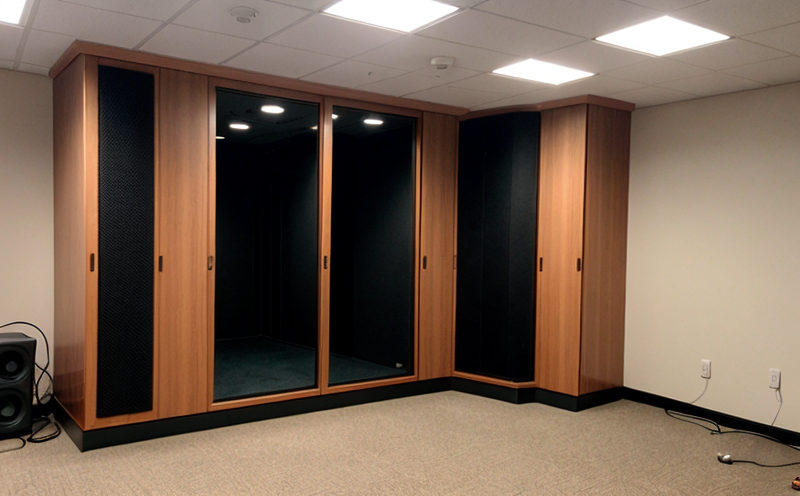ANSI/ASA S1.10 Calibration of Sound Level Meters and Analyzers
The ANSI/ASA S1.10 standard is a critical benchmark in acoustics, ensuring the accuracy and reliability of sound level meters (SLMs) and noise analyzers used across various industries. This standard provides detailed procedures for calibrating these devices to ensure they meet stringent performance criteria. The calibration process involves meticulous adjustments to achieve consistency with reference standards, which are essential for accurate measurements in noisy environments.
Calibration under ANSI/ASA S1.10 is particularly important because sound level meters and noise analyzers play a pivotal role in compliance with international safety regulations and industry-specific standards. This standard ensures that the devices can accurately measure sound pressure levels (SPLs) across a wide range of frequencies, from low to high decibels.
The calibration process involves several key steps:
- Environmental Setup: The testing environment must be controlled to prevent external noise interference and ensure stable temperature conditions.
- Reference Standard Comparison: The SLM or analyzer is compared against a reference standard under specified conditions.
- Frequency Response Adjustment: Corrections are made to the frequency response of the device to align it with the ANSI/ASA S1.10 criteria.
- Data Logging and Reporting: Detailed logs of calibration adjustments and results are maintained for future reference.
In industries such as construction, manufacturing, and environmental monitoring, accurate sound level measurements are paramount. For example, in construction sites, noise levels need to be monitored closely to ensure compliance with health and safety standards. In manufacturing plants, continuous noise monitoring helps identify potential issues that could affect worker health.
The ANSI/ASA S1.10 standard ensures that the devices used for these critical measurements are accurate and reliable, thereby enhancing the overall quality of work and protecting workers from potential hazards associated with excessive noise exposure.
Industry Applications
In construction projects, sound level meters are used to monitor ambient noise levels during operations to ensure compliance with local regulations. For instance, on a site where concrete is being poured, the SLM can be calibrated using ANSI/ASA S1.10 to provide accurate readings of the noise generated.
In manufacturing facilities, continuous monitoring of noise levels in different areas helps identify sources of excessive noise and implement corrective measures. By calibrating these devices according to ANSI/ASA S1.10, manufacturers can ensure that their operations are safe for workers.
The standard is also widely used in environmental protection agencies to monitor noise pollution levels in residential areas. Accurate measurements help enforce regulations and improve the quality of life for residents.
In research facilities, SLMs calibrated under ANSI/ASA S1.10 are used to study the effects of different sound environments on human health and behavior. This ensures that experimental results are reliable and can be trusted by the scientific community.
Eurolab Advantages
At Eurolab, we pride ourselves on providing top-tier calibration services for sound level meters and noise analyzers compliant with ANSI/ASA S1.10 standards. Our team of experts ensures that every device is calibrated in a controlled environment to meet the highest industry standards.
Accurate Measurements: We use advanced technology and state-of-the-art facilities to ensure precise measurements, which are critical for maintaining compliance with international standards.
Comprehensive Support: Our team provides comprehensive support from initial consultation through final calibration. This ensures that our clients understand the entire process and its implications.
We also offer quick turnaround times on our services, allowing you to get back to your operations with minimal disruption. Our commitment to excellence is reflected in the numerous positive reviews we have received from satisfied clients across various sectors.
Quality and Reliability Assurance
The ANSI/ASA S1.10 standard places stringent requirements on the calibration process, ensuring that sound level meters and noise analyzers are reliable tools for their intended use. This is crucial in industries where accurate measurements can have significant impacts.
Frequency Range: Devices calibrated under this standard must accurately measure SPLs across a wide range of frequencies, from 20 Hz to 16 kHz, ensuring comprehensive coverage.
Sensitivity and Resolution: The devices must meet specific sensitivity and resolution criteria set by ANSI/ASA S1.10 to ensure that even the subtlest changes in sound pressure levels are detectable.
Quality assurance is further enhanced through regular maintenance checks, which help identify any potential issues before they become critical problems. This proactive approach ensures that your devices remain reliable and accurate throughout their operational life.
We also offer training sessions for your personnel to ensure they understand the importance of proper calibration and how to perform it correctly. This not only enhances the reliability of your measurements but also fosters a culture of quality within your organization.





